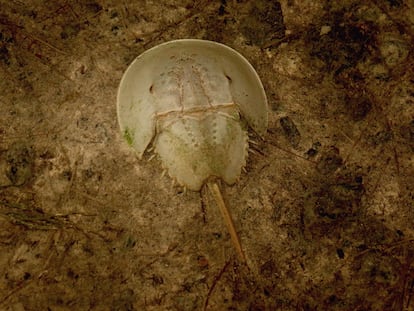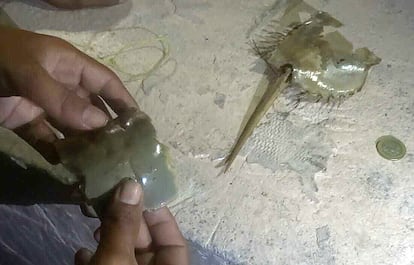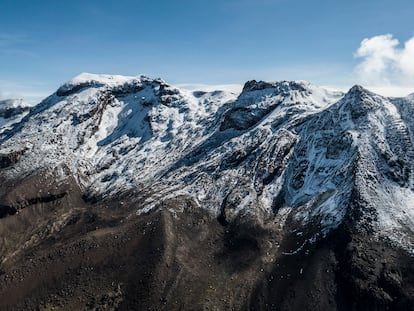Horseshoe crabs: The animal that survived 200 million years, but was not prepared for mankind
The species has been around longer than the dinosaurs, but it is facing new threats from illegal extraction, habitat loss and abusive harvesting practices

It’s a difficult creature to even imagine. The Limulus Polyphemus, or Atlantic horseshoe crab, has five pairs of eyes, which it uses to orient itself while it swims, detect light, and move toward it. The arthropod can also identify some tones from the ultraviolet spectrum in sunlight and the glare from the moon. The eyes can see in practically all directions: ahead, behind, upward and downward. It has five pairs of legs with small claws and another pair that helps it to bury itself under the sand. These appendages help it to move, but also to shred its food. They have an exoskeleton, a very hard shell, and a long pointed tail that may look threatening, but that is actually used mainly to turn upright and that moves from side to side. Their blood contains an enzyme that, when it comes into contact with oxygen, turns a strong, fluorescent blue color, and which holds a secret that is worth millions of dollars to the global pharmaceutical industry.
The scientific name refers to Polyphemus, the most famous of the Cyclopes in Greek mythology, a giant who was the son of Poseidon. While it is known in the United States as a horseshoe crab, it has little relation with other crab species, and actually has more in common with scorpions and spiders.
On the Yucatán Peninsula, the only region in Mexico where they are found, their anatomy has sparked the imagination of many who have come across them. They featured in the stories of the Spanish conquistadors and in Popol Vuh, the sacred text of the Maya peoples – they even made an appearance on the TV show The Simpsons. In Mexico, they are referred to as guitarrita (little guitar), soldadito (little soldier) or cucaracha de mar (sea cockroach). But the most common reference is cacerolita de mar (little sea saucepan) or mex, a Mayan term that is still used on the peninsula.
“The mex is as important to the culture of Yucatán as the pheasant or deer, but unfortunately it is likely that within 10 or 15 years it will no longer be with us,” explains the Marine Science doctor Juan Sandoval Gio, an academic from the Tizimín Institute of Technology. The horseshoe crab is a chapter in Yucatán’s collective memory, of children who would go to the beach and end up fascinated by these little creatures. Sandoval Gio was one of these children. He is now a scientist who focuses his studies on the animal, and warns that for decades now, there have been ever fewer of them and they are less and less known. Limulus polyphemus is a species under threat of extinction in Mexico. “The disappearance of this animal would mean the erasure of part of the history of Yucatán,” he explains.

“We are talking about a living fossil,” explains Sandoval Gio. The horseshoe crabs are the closest living relative to trilobites and the first examples date from between 200 and 250 million years ago – that makes them older than the dinosaurs. “They have survived a number of mass extinctions and are an open book to understand what the planet was like millions of years ago,” the specialist adds.
Biologist Héctor Ortiz, an academic from the Chetumal Technological Institute, explains that they are a panchronic species: extraordinarily old and with very few evolutionary changes. It is precisely this window into the past that they offer that is one of the most attractive elements for scientists, but also for the pharmaceutical industry.
Their blue blood, also known as hemolymph, is extracted from thousands of specimens in the United States, in industrial quantities. The immune system of the animal is so archaic that its blood forms clots when it detects external pathogens. It’s an intrusion detection system as rustic as it is effective, and it is widely used in tests for the purity of vaccines.
The substance extracted from them for scientific testing is known as Limulus amebocyte lysate, and is a key ingredient in the development of drugs. A gallon of blue blood (3.78 liters) is worth as much as $60,000 (€54,280) in the United States, where its extraction is legal. Ortiz explains that each organism can provide between 50 and 400 milliliters of the liquid, depending on their size and maturity. The majority of the animals survive this “milking” process, but the literature that has been revised by Ortiz suggests that around 30% of them die. There are no conclusive studies about mortality, but the abusive harvesting of horseshoe crabs has caused their populations in the United States to fall 75% from the 1980s to the first decade of the 2000s, according to the US Fish and Wildlife Service.
Since then, the European Union has promoted synthetic alternatives to amebocyte lysate, but their use was not approved in the US. In 2020, when the Covid-19 pandemic hit and the world was desperately seeking vaccines, a number of US media outlets, including National Geographic, voiced the concerns of environmental organizations that testing the purity of multiple prototype coronavirus vaccines could reduce Atlantic horseshoe crab populations even further, but there is not enough scientific evidence to prove this impact.
Nonetheless, there are articles in specialized magazines that document the harvesting of horseshoe craps since the end of the 19th century, mostly for their use as fertilizers in the agriculture sector. This was the case until the 1970s, when the lysate boom occurred thanks to its biomedical application. In Asia, similar varieties of the horseshoe crab that are found in America are consumed as a foodstuff by the population. In fact, the animals were also eaten in Mexico a few decades ago, according to the researchers consulted by EL PAÍS, but this is now a very rare practice.

Natural predators and small mammals also consume the crabs when they arrive on the coast to spawn or fertilize their eggs. A female can lay tens of thousands of eggs throughout their lives, although only a fraction of them will make it to adulthood.
In Mexico, the threats are different. For years now, residents in protected areas have been reporting the illegal extraction of the animals by fishermen. Horseshoe crabs have a high protein content, meaning that they attract octopus. A single piece of crab can be used as bait up to 10 times, according to the research by Sandoval, Gio, Ortiz and other academics. Researchers took samples from the populations in two areas of the peninsula to measure the impact. At the start of the octopus-fishing season in 2017, they found 24 specimens in San Felipe and 22 in Río Lagartos, which is a very small number. A year later, at the start of the 2018 season, they only found two of the crabs in Río Lagartos and none at all in San Felipe.
In recent years, the Federal Attorney’s Office for Environmental Protection has protected more than a hundred specimens to flow their furtive extraction for fishing. Boats are stopped, and the animals are seized, but the problem persists. The latest reports that reached the press are as recent as this January. A kilo of the crabs can be sold in some of the poorer municipalities of Yucatán at 100 pesos a kilo (less than $5), according to local media outlets.
This is not the only threat to have been documented by researchers. Work by Sandoval Gio published several months ago has found, for the first time, the herbicide glyphosate in dead specimens. How did it end up in the body of an arthropod? The researcher points to the use of chemicals on extensive crops in Yucatán, where the ground is chalky and very porous. This results in toxic substances ending up in aquifers and the estuaries where the mex live. The problem has the potential to snowball: from the crops to the crabs, from illegal extraction to octopus fishing, and from the plate to the bodies of humans. “It’s a chain,” explains Ortiz. Mexico prohibited the use of glyphosate in January 2021.
As well as the issue of pollution, policy on land use is also changing thanks to the explosion of tourism. The critical habitats for horseshoe crabs are getting ever smaller, Ortiz warns. On the right side of the Yucatán Peninsula there is a vibrant tourism sector on the Riviera Maya, and other coastal areas of the peninsula, some of them in protected areas, are looking with envy at the arrival of visitors and their spending money.
Ortiz has spent more than two decades studying this species. The researcher recalls his field trips at the end of the 1990s to Holbox, a small fishing village on a semi-paradisiacal island, almost at the start of the Mexican Caribbean. There was nothing there, the roads hadn’t even been paved and there were no motorized vehicles. “When you got to the dock you’d see the horseshoe crabs arriving,” he explains. But soon the tourists came too, and now there is more and more trash, hotels, trucks and houses in areas where construction was prohibited, as well as hammocks and bars right on the beach – where the crabs usually reproduce.
“It’s really sad, it’s a huge deterioration,” he complains. In Champotón, in Campeche state, Ortiz remembers having seen the crabs looking for places to spawn in areas covered with cement. “You don’t see the crabs any more, there are very few of them. [...] They are a little-studied and under-valued species in Mexico.”
Local researchers have realized in recent years that they had to join forces to get further with their work. They have promoted education in local communities in order to raise awareness about cultural and environmental values. And they are putting on pressure so that conservation efforts are coordinated and effective, in order to preserve a unique and naturally timid species, one that is ever-more hidden and rare, that survived millions of years on Planet Earth, but was not prepared for the arrival of mankind.
Tu suscripción se está usando en otro dispositivo
¿Quieres añadir otro usuario a tu suscripción?
Si continúas leyendo en este dispositivo, no se podrá leer en el otro.
FlechaTu suscripción se está usando en otro dispositivo y solo puedes acceder a EL PAÍS desde un dispositivo a la vez.
Si quieres compartir tu cuenta, cambia tu suscripción a la modalidad Premium, así podrás añadir otro usuario. Cada uno accederá con su propia cuenta de email, lo que os permitirá personalizar vuestra experiencia en EL PAÍS.
¿Tienes una suscripción de empresa? Accede aquí para contratar más cuentas.
En el caso de no saber quién está usando tu cuenta, te recomendamos cambiar tu contraseña aquí.
Si decides continuar compartiendo tu cuenta, este mensaje se mostrará en tu dispositivo y en el de la otra persona que está usando tu cuenta de forma indefinida, afectando a tu experiencia de lectura. Puedes consultar aquí los términos y condiciones de la suscripción digital.
More information

The death of the last glaciers in Mexico
Últimas noticias
Most viewed
- Reinhard Genzel, Nobel laureate in physics: ‘One-minute videos will never give you the truth’
- Oona Chaplin: ‘I told James Cameron that I was living in a treehouse and starting a permaculture project with a friend’
- Pablo Escobar’s hippos: A serious environmental problem, 40 years on
- Why we lost the habit of sleeping in two segments and how that changed our sense of time
- The fall of a prolific science journal exposes the billion-dollar profits of scientific publishing










































